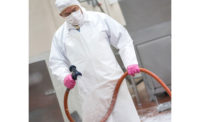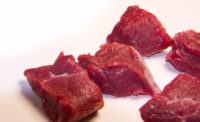Contaminated meat poses significant dangers to public health. Its consumption can lead to various foodborne illnesses caused by pathogens such as E. coli and Salmonella, to name a few.
Ground meat and non-solid meat products are at greater risk of contamination because of the greater surface area compared to whole muscle products. This scenario increases contact with the processing equipment and potential pathogen transfer and contamination. As ground meat traverses through processing equipment, pathogens mix throughout the product instead of resting on outside surfaces, making it more challenging to detect contamination.
A summary of 2022 conducted by the USDA Food Safety and Inspection Service (FSIS) tallied more than 1.7 million pounds of meat products recalled in 45 separate incidents across various species. A recent recall this year affecting Conagra Brands’ canned meats represented more than 2.5 million pounds (about 1133980 kg) of product.
A joint industry study conducted by the Food Marketing Institute and the Grocery Manufacturers Association estimated the average cost of a recall to a food company at $10 million, but it can go much higher, very quickly.
The role of pump design in food safety
Often a rotary displacement pump (usually a lobe pump) is utilized within a food processing plant to transfer highly viscous material like ground meats. Proper equipment sanitation and sanitary pump design play a vital role in preventing pathogen collection and transfer.
Because the process material is thick and has high fat content, pumps cannot be adequately cleaned and sanitized using clean-in-place systems. Clean-out-of-place (COP) routines are common in the meat and poultry and dairy industries, because of the safety risks associated with these food products. Food processors, particularly in egg and meat applications, must be vigilant about preventing e. coli outbreaks. Plant managers often prefer manual COP for the control it lends to sanitation processes.
The benefits of properly conducted COP processes
- Prevent contamination by thoroughly cleaning surfaces that encounter the meat product.
- Prevent cross-contamination. Occurs when pathogens or other contaminants transfer from one area of the production line to another, resulting in widespread contamination of the final product. It points out the vital importance of thoroughly cleaning pumps and equipment. An improperly cleaned pump can become a source of cross-contamination.
- Comply with food safety regulations. Both CIP and COP processes are considered preventive controls according to the FDA’s Food Safety Modernization Act (FSMA), which requires preventive controls in food production.
- Maintain product quality. Product shelf life and quality depend on food safety measures such as sanitation processes.
Despite its advantages, COP processes pose several challenges to meat processing operations.
COP can be labor intensive. Cleaning scheduled during the third shift or a night shift means a lower-skilled workforce -- assuming plant operators can adequately staff a late-night shift.
COP is where 90% of pump damage occurs or where parts are lost. Pumps are engineered to specific tolerances and sanitary-finish standards, yet cleaning crews do not always handle parts with care, leading to bent parts, nicks, and misalignment. Pump parts like gaskets can be lost during pump reassembly and introduced into the food stream, causing a recall that is not linked to a pathogen but is no less costly.
COP may pose risks to worker safety. Managers are concerned that a worker might drop heavy parts and injure themselves. The parts can be slippery and hard to handle, particularly with meat products and the levels of oil and grease.
The COP process is time-consuming and can be confusing. There might be many parts to a pump, making it more difficult to reassemble properly, and depending on the pump design, COP can be responsible for a significant amount of downtime. Surprisingly, many pump manufacturers use the same design for CIP and COP applications.
Hygiene extends to material selection and pump design
Some pump suppliers are taking note of the labor force challenges, the difficulty of pump assemblies, downtime, and subsequent production loss.
The industry responds by offering pumps designed for fast disassembly for reduced downtime. Pumps may be designed with fewer parts, reducing the risk of foreign objects entering the food stream. Some pumps now feature hinged, attached covers that eliminate the risk of dropping this heavy part. A pump designed for one-way assembly can ensure proper alignment and prevent pump damage.
An industry adage says, “you can’t sanitize a dirty surface.” Materials used for pump construction must be suitable for contact with food products and FDA (Food and Drug Administration) compliant. FDA Code of Federal Regulations (CFR) Title 21 dictates the materials for equipment and component fabrication, for parts that will encounter food ingredients.
Pump design considerations should include 3A certification, including elastomeric seals. In addition, a sanitary design includes smooth or continuous welds or welds on outer surfaces for a seamless interior. A smooth interior without crevices helps prevent material buildup and “dead zones” which provide breeding grounds for bacteria. Smooth surfaces also facilitate cleaning and sanitation.
Best practices for food safety procedures begin well before equipment ever enters the facility. Meat processors can enhance food safety and help prevent costly recalls with the proper initial selection of a pump designed to optimize hygiene while simplifying the labor involved in cleaning.
Calle Danielsson is a engineer at Unibloc Hygienic Technologies.









